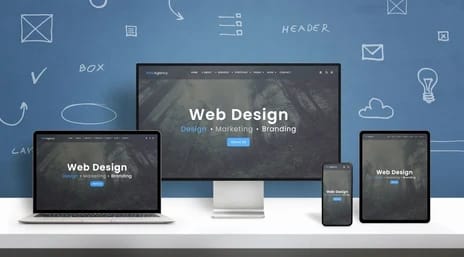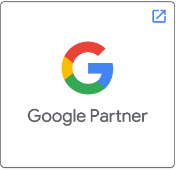Table of Contents
Web design is a constantly evolving field, and as we head into 2023, there are a number of trends that are poised to take center stage. These trends range from the use of dark mode and asymmetry in design to the incorporation of 3D elements and micro-animations. In this blog post, we’ll take a closer look at some of the top web design trends for 2023 and discuss how you can use them in your own work to create visually appealing, engaging websites that stand out from the crowd with professional web design services.
Dark Mode
One of the biggest web design trends for 2023 is the use of dark mode. With more and more people using their devices in low-light settings, the dark mode has become increasingly popular. This design trend not only looks sleek and modern, but it also helps to reduce eye strain and battery consumption. Dark mode is a great way to create a sense of contrast on your website, and it can be used to highlight important elements of your design. To implement dark mode on your website, you can use CSS media queries to automatically switch to a dark mode when the user’s device is in low-light mode.
Asymmetry
Another trend that we’re likely to see more of in 2023 is asymmetry. Symmetry has long been a staple of web design, but in 2023, we’re likely to see more asymmetrical layouts. This gives designers more flexibility to create unique and interesting designs that stand out from the crowd. Asymmetrical layouts can be used to create a sense of movement and dynamic energy on your website, and they can be used to highlight important elements of your design. To create an asymmetrical layout, you can use CSS grid and flexbox to create a layout that is not symmetrical with the help of the best web design services.
Dynamic Gradients
Dynamic gradients are another trend that we’ll see more of in 2023. Gradients have been popular in web design for a while, but in 2023 we’ll see more dynamic gradients that change and adapt in response to user interactions. This can add a sense of depth and movement to a website, and it can be used to create a sense of visual interest. To create a dynamic gradient, you can use CSS animations and transitions to create a gradient that changes over time.
3D
In 2023, we’ll also see more 3D elements being used in web design. 3D design elements are becoming more prevalent on the web, allowing designers to create more immersive experiences for users. This can include 3D images and animations, as well as the use of virtual and augmented reality. 3D elements can be used to create a sense of depth and realism on your website, and they can be used to make a sense of visual interest. To create 3D elements, you can use CSS 3D transforms and WebGL.
Micro-animations
Another trend that we’ll see more of in 2023 is the use of micro-animations. Micro-animations are small animations that add subtle movement and interactivity to a website. These can include things like hover effects, scrolling animations, and more. They add visual interest and make a website feel more alive. Micro-animations can be used to create a sense of movement and energy on your website, and they can be used to create a sense of visual interest. To create micro-animations, you can use CSS animations and transitions.
Voice Interface
Voice Interface is another trend that is going to be more prevalent in 2023. Voice Interface is becoming a norm, and more and more people are using voice commands to navigate their devices. This trend will be more prevalent in 2023, with more and more websites and apps incorporating voice interfaces to make it easier for users to find what they need. Voice Interface can be used to create a more natural and intuitive user experience, and it can be used to Another trend that is set to become more popular in 2023 is the use of voice interfaces. With the rise of smart devices such as Amazon Echo and Google Home, more and more people are becoming accustomed to using voice commands to navigate through their devices. This trend is set to continue in 2023, with more and more websites and apps incorporating voice interfaces to make it easier for users to find what they need.
Voice interfaces can be used to create a more natural and intuitive user experience, and they can be used to improve accessibility for users with disabilities. For example, a voice interface can be used to allow users to navigate through a website using spoken commands, rather than having to use a mouse and keyboard. To implement a voice interface on your website, you can use technologies such as Web Speech API and Speech Recognition API. If you are looking to add voice interfaces to your website then hiring the best web design services in Chennai will help you!
Conclusion
There are many advantages to utilizing some of the above trends. They may improve the standard for your website, establish trust and credibility, encourage much-needed user engagement, strengthen the brand’s great reputation, and most significantly, connect with the audience by delivering the proper message and creating a lasting positive impression. Take these things carefully and consider the preferences of your target market and market sector to determine which trends will work best for you.
FAQ
How to maximise ROI with custom web design?
There are a few things you can do to maximise ROI with custom web design:
- Set clear goals: What do you hope your website will accomplish? Which goals are you trying to achieve? Lead generation, sales, or brand awareness? Once you know your goals, you can work with your web design company to develop a plan to achieve them.
- Track your results: Use analytics tools to track your website's performance and see how it is helping you achieve your goals. This data will help you make necessary adjustments to your website and improve your ROI.
- Invest in SEO: Getting potential clients to see your website requires SEO. To rank better in search results, work with your web design company to optimise your website for search engines.
- Promote your website: After your website is operational, you must advertise it to get visitors. Use social media, email marketing, and other marketing channels to reach your target audience and drive traffic to your website.
How to choose a web design company in Chennai?
When choosing a web design company in Chennai, there are a few things to keep in mind:
- Experience: Go with a company that has created websites for companies in your sector of the economy.
- Portfolio: Review the company's portfolio to see if their work style aligns with your vision for your website.
- Communication: Choose a company that is responsive to your needs and communicates effectively throughout the design process.
- Cost: Compare prices from different companies to find the best deal for your budget.
What are the benefits of custom web design for SEO?
There are many benefits of custom web design for SEO, including:
- Improved search engine optimization (SEO): A custom web design can be optimized for search engines, which will help you rank higher in search results and attract more visitors to your website.
- Increased brand awareness: A custom web design can help you create a strong and consistent brand identity online.
- Improved user experience: A custom web design can be tailored to the specific needs of your users, providing them with a positive and engaging experience.
- Increased sales and leads: A custom web design can help you generate more leads and sales by providing visitors with the information and tools they need to take action.
What is custom web design?
Custom web design is the process of creating a website that is tailored to the specific needs and goals of your business. This includes taking into account your target audience, brand identity, and goals for the website. A custom web design can help you stand out from the competition and create an engaging user experience that will keep visitors coming back for more.
What are some tips for maximizing conversions with strategic web design?
Here are a few tips for maximizing conversions with strategic web design:
- Make sure your website is mobile-friendly.
- Use clear and concise calls to action.
- Offer valuable content.
- Test and optimize your website regularly.
How do I choose the best web design company in Chennai?
The following criteria should be taken into account when hiring a web design firm:
- Experience: Choose a company with experience in designing websites for businesses in your industry.
- Process: Ask the company about their web design process. A good web design company will have a clear and concise process that involves you at every step.
- Quote: Get a quote from a few different web design companies before making a decision.
What are the benefits of strategic web design?
A well-designed website can help you achieve a number of business goals, including:
- Increased conversions
- Improved SEO
- Better user experience
- Increased brand awareness
What is web design?
Web design is the process of creating the visual appearance and user interface of a website. It involves elements such as layout, typography, color scheme, and imagery. Web designers work to create websites that are both visually appealing and easy to use.
Should I employ an expert in SEO, or can I do it myself?
You can do basic SEO yourself, but hiring a professional SEO agency is recommended for the best results. SEO experts have in-depth knowledge and tools to optimize your website effectively and keep up with search engine algorithm changes.
When can I expect to start seeing SEO effects for my website?
SEO is a long-term strategy. You may start seeing improvements in a few months, but significant results often take several months to a year, depending on competition and the effectiveness of your SEO efforts.
What should I look for in a web design company in Chennai?
When choosing a web design company, consider their portfolio, experience, customer reviews, and their ability to create mobile-responsive, user-friendly websites. Ensure they also understand SEO best practices.
How does SEO benefit my website's visibility?
SEO, or search engine optimization, helps your website rank higher in search results. This increased visibility drives organic traffic, improves online presence, and can lead to more potential customers finding your site.
What is the significance of web design for my online business?
Web design is crucial as it creates the first impression of your business online.Both the user experience and the search engine rankings of your website may be impacted.
What is the importance of website layout design and composition?
Website layout design and composition are essential for creating a website that is visually appealing, easy to use, and search engine friendly. A well-designed website will help you attract more visitors, improve your chances of ranking high in search engine results pages (SERPs), and convert more visitors into customers.
What are the benefits of using a responsive website layout?
- Better user experience: Responsive websites work well on all devices, so users can have a consistent experience no matter how they're accessing your site.
- Improved SEO: Responsive websites are easier for search engines to crawl and index, which can help improve your website's search engine ranking.
- Reduced costs: Responsive websites are typically less expensive to develop and maintain than separate mobile and desktop websites.
- Increased mobile traffic: More and more people are using their mobile devices to access the internet, so a responsive website will help you reach a wider audience.
- Improved conversion rates: Responsive websites can help you increase your conversion rates by providing a better user experience and making it easier for users to find what they're looking for.
- Enhanced branding: A consistent design across all devices can help you create a stronger brand identity.
What is the difference between website layout and composition?
- Layout is the arrangement of elements on a page for functionality.
- Composition is the arrangement of elements on a page for aesthetics.
Together, layout and composition can create a website that is both easy to use and visually appealing.
What are the benefits of improving my website's load time?
There are a number of benefits to improving your website's load time. These benefits include:
- Improved user experience: A faster-loading website will provide a better user experience for your visitors. Lower bounce rates and increased conversion rates may result from this.
- Improved SEO: According to Google, their algorithm takes page speed into account when determining rankings. Accordingly, websites that load more quickly has a higher chance of appearing higher in search engine results pages (SERPs).
How can I improve my website's load time?
There are a number of things that you can do to improve your website's load time. Some of these tips include:
- Optimize your images: You can optimize your images by reducing their file size and using the correct image format.
- Minify your code: Minifying your code removes unnecessary whitespace and comments, which can help to improve your website's load time.
- Use a content delivery network (CDN): A CDN is a network of servers that deliver your website's content from the closest server to the user. This can aid in reducing the time it takes for users from around the world to load your website.
What are some of the most common reasons why websites load slowly?
The following are some of the most frequent causes of sluggish webpage loading:
- Larger photos: One of the most frequent reasons why websites load is slowly being graphed. This is because images can be large in file size, which can take a long time to download.
- Complex code: Complex code can also slow down a website. This is because the browser has to spend more time parsing and executing the code.
- Too many plugins: Too many plugins can also slow down a website. This is because each plugin adds additional code that the browser has to load and execute.
What is a good website load time?
Generally speaking, a good website load time is around 3 seconds. However, the ideal load time will vary depending on the type of website and the target audience. For example, a website that is used for e-commerce may need to load even faster than 3 seconds, as users are more likely to abandon their carts if the website takes too long to load.








